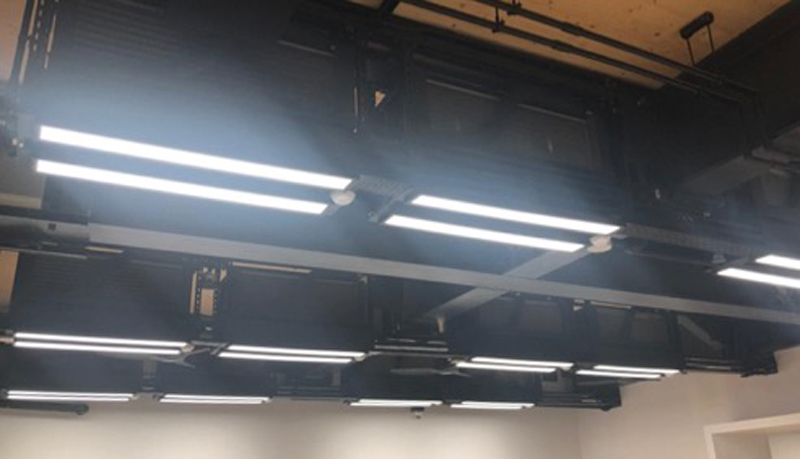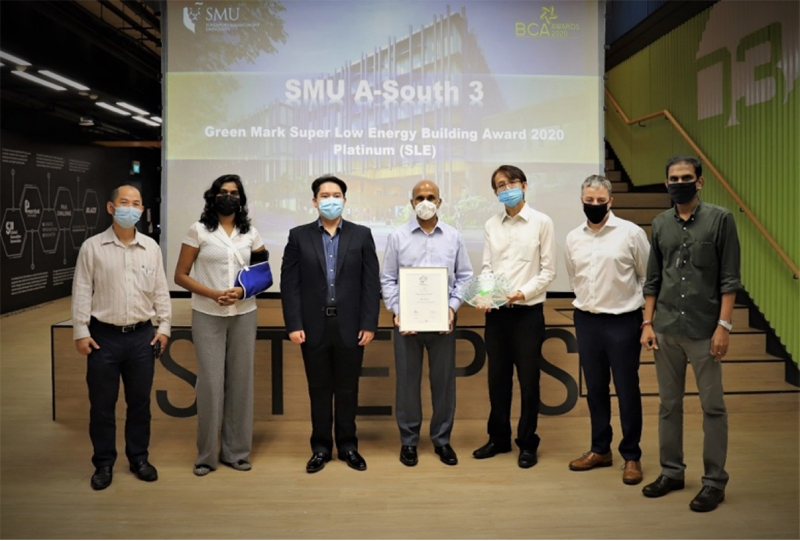SMU is committed to environmental sustainability and making its city campus truly iconic by building quality infrastructure and facilities, developed using sustainable features, to support its dynamic pedagogical and operational requirements.
- Mr Sundar Selvam, Vice-President, Office of Campus Infrastructure and Services, SMU
Building owners are doing their part to join the fight against climate change, with more green buildings clinching the Building and Construction Authority (BCA) Super Low Energy (SLE) Buildings Award.
Currently, the building sector is responsible for more than one-third of the country’s total electricity consumption. BCA is working closely with the built environment sector to push for higher green building standards in order to meet its climate change commitments.
To this aim, BCA launched the BCA Green Mark Super Low Energy Building (GM SLE) Award—the pinnacle level of certification—in 2018 to encourage industry to push boundaries on energy efficiency, and recognise green buildings that demonstrate best-in-class energy performance and efficiency in a cost-effective manner.
|
|
The ASouth3 building has a self-shading building form and an external corridor layout, which help to avoid direct radiant heat gain and prevent visual discomfort.
|
|
One of the BCA 2020 Awards’ outstanding awardees is the Singapore Management University (SMU) ASouth3 building, which obtained the prestigious GM SLE Award as a new, non-residential building. The institute of higher learning tastefully blends active and passive design strategies. It adopted high-impact energy efficiency measures, while ensuring the comfort and safety of its students, faculty and staff members throughout.
Mr Sundar Selvam, Vice-President, Office of Campus Infrastructure and Services, SMU, said, “SMU is committed to environmental sustainability and making its city campus truly iconic by building quality infrastructure and facilities, developed using sustainable features, to support its dynamic pedagogical and operational requirements.”
Highlights of SMU ASouth3’s sustainable features include:
Architecturally expressive and passive self-shading features
Self-shading features including the building form, shading devices and insulated building envelope with low-energy double glazing enabled SMU ASouth3 to minimise glare and heat absorption, while reducing the reliance on artificial cooling systems and overall building energy consumption.
|
|
 The building’s innovative Enhanced Passive Displacement Cooling (EPDC) System circulates air by convection, thus significantly reducing energy usage. The building’s innovative Enhanced Passive Displacement Cooling (EPDC) System circulates air by convection, thus significantly reducing energy usage.
|
|
Energy Efficient Chiller Plant
SMU ASouth3 utilises chilled water from the existing Water-Cooled Chiller Plant located at the School of Law (SOL). The chiller plant has an efficiency of 0.611kW/RT and has helped in achieving a 32% improvement over the Green Mark baseline.
Enhanced Passive Displacement Cooling (EPDC) System
Air-conditioned spaces use the innovative EPDC System, which does not consume power, to circulate the air within a room. Instead, air is circulated by a convection process with the natural buoyancy of hot and cold air to significantly reduce energy requirements.
Renewable energy
An on-site 420 kWp Photo Voltaic System generates 11% of the total building energy consumption.
Converged Power System (CPS)
Instead of the conventional Uninterruptable Power Supply (UPS), SMU ASouth3 uses a Converged Power System (CPS), which converges batteries for Vac system and Vdc system into a single system to save space, maintenance costs and reduce power losses.
Optimised lighting
SMU ASouth3 utilises natural daylight and adopts an array of other lighting features such as dimming control, photocell and occupancy lux sensors as well as LED lighting to achieve significant energy savings.
SMART building control system
The building leverages a SMART building control system with thermal and CO2 sensors to achieve optimum energy consumption while ensuring occupant’s thermal comfort.
Mass Engineered Timber (MET) structure
The MET structure of the building employs sustainable construction material from responsible sources that reduces the embodied carbon of the building and its overall carbon footprint.
|
|
 Team from SMU receiving the GM SLE award from Dr Edward Ang, Director of Super Low Energy Buildings department, BCA (third from right). Team from SMU receiving the GM SLE award from Dr Edward Ang, Director of Super Low Energy Buildings department, BCA (third from right).
|
|
SMU’s latest sustainability win makes good on a pledge to achieve at least one SLE project. Despite a growing student population and campus size, SMU was able to substantially reduce both its energy intensity and water index consumption by 40% and 30% by the target year of 2020, from the baseline years of 2006 and 2011 respectively.
Mr Selvam elaborated on the achievement, “Beyond hardware improvement, concerted efforts through ground-up and management led awareness activities have contributed to a noticeable shift in the behaviour of SMU faculty, staff and students in becoming more proactive in conserving water and electricity. In addition to the SMU community, the efforts of our industry partners like consultants and contractors, equipped with the latest global industry knowledge and technological know-how, have made the realisation of these goals possible.”
This award is not the first time SMU has been recognised for its commitment to sustainability. To name a few previous awards: Leadership in Sustainable Design & Performance/Award by SGBC & BCA in 2016, ASEAN Best Practices Award-Energy Efficient/Regional Buildings by ASEAN Centre for Energy in 2016, Cities the Community in Bloom Awards (Gold) by National Parks Board in 2017, the Singapore Environmental Achievement Awards (Merit Winner) by the Singapore Environment Council in 2018, and BCA Green Mark (Platinum) 100% status for the Campus in 2019.
In 2020, a total of 22 buildings obtained the GM SLE Award, including 3 Positive Energy and 3 Zero Energy buildings. To date, a total of 39 projects involving 50 industry stakeholders have been accorded the accolade. The upward trend is encouraging as it shows that more building owners and developers are recognising the business case for sustainability. Not only do green buildings have a positive impact on the environment, they also accrue long-term value and savings that outweigh the initial investment.
SLE Buildings must achieve at least 40% energy savings based on prevailing code, or equivalent to 60% energy savings above the 2005 building code. Examples of energy efficient innovations that SLE buildings feature include the use of intelligent energy management strategies such as SMART building control systems, onsite and offsite renewable energy as well as optimal lighting and material.
Client/Developer: Singapore Management University
Architect: MKPL Architects Pte Ltd
M&E Engineer: Meinhardt (Singapore) Pte Ltd
Structural Engineer: Meinhardt (Singapore) Pte Ltd
Quantity Surveyor: Rider Levett Bucknall Pte Ltd
Main Contractor: Lian Ho Lee Construction Pte Ltd
ESD Consultant: Web Earth Pte Ltd